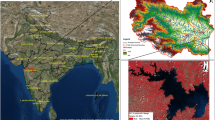Abstract
Globally, water and energy demands are increasing continuously, while the storage capacity of structures like dams and reservoirs is reducing due to sediment-induced problems. Study of the reservoir sedimentation is essential for restoring the storage capacities to ensure the increasing water and energy demands. This study suggested the methodology for preparing the revised elevation–area–capacity curve for a reservoir for its efficient use. Also, it focused on two important issues through an example—estimation of the loss of the live storage capacity of the reservoir due to sedimentation and remedial measures to regain the lost capacity. In the present study, reservoir sedimentation is estimated using satellite remote sensing technique (SRS) considering a case of the Ujjani reservoir located in Maharashtra State, India. The modified normalized difference water index (MNDWI) is employed to determine the water surface area using ERDAS Imagine software. The loss in live capacity because of deposition of sedimentation over 41 years is determined and estimated to be 174.592 Mm3 showing the rate of capacity loss as 4.26 Mm3/year, which is 11.23% loss of the original capacity under study zone. To regain the storage capacity of the reservoir, it is proposed to adopt manual and or mechanical dredging with flushing for desilting the deposited sediment in the reservoir.






Similar content being viewed by others
References
A.K. Kadam, T.H. Jaweed, S.S. Kale, B.N. Umrikar, R.N. Sankhua, Identification of erosion-prone areas using modified morphometric prioritization method and sediment production rate A remote sensing and GIS approach. Geomat., Nat. Hazards Risk. (2019). https://doi.org/10.1080/19475705.2018.155189
A. Pandey, U.C. Chaube, S.K. Mishra, D. Kumar, Assessment of reservoir sedimentation using remote sensing and recommendation for desilting patratu reservoir India. Hydrol Sci. J. (2016). https://doi.org/10.1080/02626667.2014.993988
C.J. Vorosmarty, M. Meybeck, B. Fekete, K. Sharma, P. Green, J.P.M. Syvitski, Anthropogenic sediment retention: major global impact from registered river impoundments. Global Planet. Change (2003). https://doi.org/10.1016/S0921-8181(03)00023-7
CWC, Compendium on silting of reservoirs in India. Central Water Commission, New Delhi, India. Publ. no.3, 78–97 (2015).
H. Xu, Modification of normalized difference water index (NDWI) to enhance open water features in remotely sensed imagery. Int. J. Remote Sens. (2006). https://doi.org/10.1080/01431160600589179
K.V. Singh, R. Setia, S. Sahoo, A. Prasad, B. Pateriya, Evaluation of NDWI and MNDWI for assessment of waterlogging by integrating digital elevation model and ground level. Geocarto Int. (2014). https://doi.org/10.1080/10106049.2014.965757
M.K. Goel, S.K. Jain, P.K. Agarwal, Assessment of sediment deposition rate in Bargi reservoir using digital image processing. Hydrol. Sci. J. (2002). https://doi.org/10.1080/02626660209493024
M.S. KhadatareJedhe, Sediment assessment of Ujjani reservoir in maharashtra by using remote sensing technique. Intonal Res. J. Eng. Technol. 4(8), 1255–1258 (2017)
M. Kummu, O. Varis, Sediment-related impacts due to upstream reservoir trapping, the Lower Mekong River. Sci. Direct, Geomorphol. 85, 275–293 (2007)
M. Kummu, X.X. Lu, J.J. Wang, O. Varis, Basin-wide sediment trapping efficiency of emerging reservoirs along the Mekon. Sci Direct, Geomorphol. 119, 181–197 (2010)
M. Nakil, M. Khaire, Effect of slope steepness parameter computations on soil loss estimation: a review of methods using GIS. Geocarto Int. (2015). https://doi.org/10.1080/10106049.2015.1120349
P. Cogollo, S. Villela, Mathematical model for reservoir sedimentation. Proceedings of the Porto Alegre Symposium. IAHS Publ.174, 43- 51 (1988).
P.R. Ikhar, D.G. Regulwar, R.U. Kamodkar, Optimal reservoir operation using soil and water assessment tool and genetic algorithm. ISH J. Hydraulic Eng. (2017). https://doi.org/10.1080/09715010.2017.1417754
R.K. Bhattacharya, N.D. Chatterjee, K. Das, Sub-basin prioritization for assessment of soil erosion susceptibility in Kangsabati, a plateau basin: a comparison between MCDM and SWAT models. Sci. Total Environ. (2020). https://doi.org/10.1016/j.scitotenv.2020.139474
R. Shendge, M. Chockalingam, B. Saritha, A. Ambica, Swat modelling for sediment yield: A case study of Ujjani reservoir in Maharashtra India. Int. J. Civil Eng. Technol. 9(1), 245–252 (2018)
S. Deore, The quantitative evaluation of soil erosion: A case study of Upper Bhima Basin. Major research project, S.N.D.T., University, Pune (2014).
S. Dutta, Soil erosion, sediment yield, and sedimentation of reservoir: a review. Model. Earth Syst. Environ. (2016). https://doi.org/10.1007//s40808-016-0182-y
S.K. Jain, P. Singh, S.M. Seth, Assessment of sedimentation in Bhakra reservoir in the western Himalayan region using remotely sensed data. Hydrol. Sci. J. (2002). https://doi.org/10.1080/02626660209492924
S. Mukherjee, V. Veer, S. Tyagi, V. Sharma, Sedimentation study of Hirakud reservoir through remote sensing technique. J. Spat. Hydrol. 7(1), 122–130 (2007)
Author information
Authors and Affiliations
Corresponding author
Additional information
Publisher's Note
Springer Nature remains neutral with regard to jurisdictional claims in published maps and institutional affiliations.
Rights and permissions
About this article
Cite this article
Wagh, S., Manekar, V. Assessment of Reservoir Sedimentation using Satellite Remote Sensing Technique (SRS). J. Inst. Eng. India Ser. A 102, 851–860 (2021). https://doi.org/10.1007/s40030-021-00539-8
Received:
Accepted:
Published:
Issue Date:
DOI: https://doi.org/10.1007/s40030-021-00539-8




